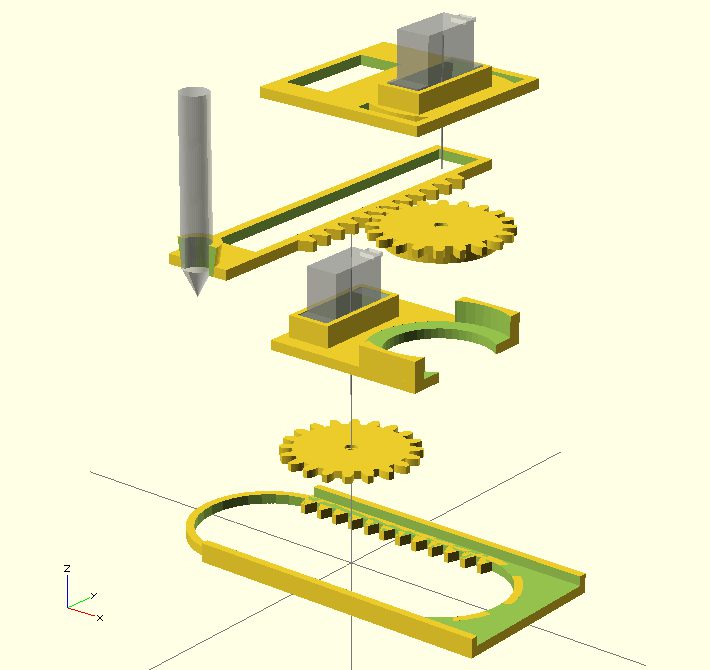I tried a little experiment last weekend.1 I listed the plastic parts for Tiny CNC version 0.18 on eBay. I did this for a number of reasons:
I really wanted to see someone else put together this robot. Also, getting rid of my only set of parts would basically force me to design and print new parts if I wanted to start another drawing. Lastly, I was genuinely curious whether anyone would actually be interested in purchasing parts. If there was enough interest, I might be able to turn this into a kit to get more robots in more peoples’ hands. If I made a little profit in the meantime, then great. The auction had six bidders with nine total bids, ending at $13.63 plus $4.00 for shipping, for a total of $17.63.
But, what’s an experiment if you don’t share the results?
- The eBay auction for the one-and-only set of plastic parts for version 0.18 I’ll ever sell ended after three days. The gentleman who purchased them made an immediate payment and I was able to swing by an office supply store, buy a padded envelope, leave work early for my house to pick up the parts, and then the post office to drop them off. I tossed in the parts from version 0.14 as well since I’m not going to use them and he might get some use from them. I received a very nice email from him today letting me know they arrived.
- Here’s the breakdown so far:2
- Plastic parts: 2.5 ounces, or 70.9 grams, of white MakerBot ABS plastic. This plastic is $52.08/kg, inclusive of shipping. This comes to $3.70 in plastic which took about 2 hours to print.
- Padded envelope: $1.62
- Postage: $4.77 total
- Postage was $2.07 for the 2.6 oz package, first class, large envelope
- I accidentally bought signature confirmation for $2.70 rather than tracking for only $0.90. So, rather than the total being $2.97, it was $4.77. D’oh!
- Three sheets of paper: $0.18
- I printed out the eBay auction, used a piece of paper to separate out the old version 0.14 parts from the version 0.18 parts, and a third sheet of paper to print the addresses
- eBay fees: $1.76
- Actually, by a total fluke, I happened to list this item on a day when there were no eBay fees! Some sort of Black Friday promotion. I didn’t even realize this until I went back to track down the eBay fees for this post. I’m listing the fees here so I can get an accurate read on the cost of listing these parts on eBay.
- PayPal fees: $0.81
- Total eBay payment: $17.63
- Total costs: -$12.84
- Net profit: $4.79
At a “profit” of $4.793 this wasn’t exactly lucrative. I’m pretty sure I’d also owe taxes on this “profit” too.
The parts took about 5 minutes of setup, 2 hours of unsupervised Replicator printing time, about 5 minutes of sanding for a better fit, and let’s say about 30 minutes of time to package and ship. This doesn’t count any of the amount of time spent on development4 , listing parts for sale5 , or telling people about the sale.6 At less than $5 for all that work, this isn’t really worth anyone’s time.7
Fortunately, 100 kits doesn’t actually take 100 times the amount of time. So, it remains possible that at a certain volume this becomes feasible to produce as a kit. I figure the advertising time for a bunch of kits would be a lot higher8 but less than 100x the time spent advertising this first set, the time spent on assembling/packing/getting ready for shipping would be about 100x, and the time spent actually shipping would be about the same as the time to ship one copy.9
More on the economics of kits in the next post…
- Photo courtesy of donbuciak [↩]
- For the time being, I’m excluding gas, mileage, electricity, wear and tear on my 3D printer, and the value of my time [↩]
- I would have made $6.59 if I hadn’t screwed up the postage – but there you go! [↩]
- 10 hours? More?? I had to update an OpenSCAD rack/pinion script, and developed versions 0.1 through 0.14 before I had something to print. [↩]
- 30 minutes – it’s been a long time since I’ve sold anything on eBay [↩]
- An e-mail to the newsletter, a two tweets, revising the Thingiverse post to show the parts were for sale [↩]
- Less than $5 for 1 hour of work is well below minimum wage [↩]
- More tweets, better copy, a video demonstration [↩]
- Since I’m hoping it would take about the same amount of time to drop off one set as it would 100+ sets at the post office [↩]


